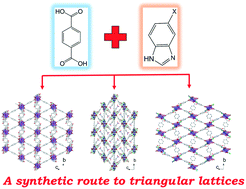Two-dimensional magnetic materials of cobalt(ii) triangular lattices constructed by a mixed benzimidazole–dicarboxylate strategy†
Abstract
Frustrated spin systems, such as triangular lattices, are of significant interest in the field of chemistry, physics and materials science. However, the design and synthesis of these systems are difficult and have occurred serendipitously. Herein, we developed a straightforward and effective strategy for the design and construction of geometrically frustrated triangular lattices based on a mixed benzimidazole–dicarboxylate strategy. Using this method, we synthesized and characterized three CoII coordination polymers (CPs), namely [Co3(1,4-BDC)3(5NO2-BIm)2(MeOH)2]n (1), {[Co3(1,4-BDC)3(5Cl-BIm)2]·2MeOH2}n (2), and {[Co3(1,4-BDC)3(5CH3O-BIm)2]·2DMF}n (3) (where 1,4-BDC = 1,4-benzenedicarboxylate, 5NO2-BIm = 5-nitrobenzimidazole, 5Cl-BIm = 5-chlorobenzimidazole, 5CH3O-BIm = 5-methoxybenzimidazole), with geometrically frustrated triangular lattices. Single-crystal X-ray diffraction studies revealed that the compounds 1–3 exhibited two-dimensional (2D) layered structures formed by the linear trimeric Co3 secondary building units. The Co3 units exhibited an Oh–Oh–Oh geometry in 1 and mixed Td–Oh–Td geometries in 2 and 3. Interestingly, the triangular lattices of 1–3 could be tuned by different benzimidazole derivatives; this resulted in the formation of distinct frustrated structures. Nitrogen adsorption–desorption isotherms indicated that the diverse Brunauer–Emmett–Teller (BET) surface areas of 1, 2 and 3 were 822, 877 and 943 m2 g−1, respectively. Magnetic measurements indicated that 1 showed the coexistence of long-range magnetic ordering and spin frustration, whereas 2 and 3 displayed a dominant frustration behavior. This simple synthetic method provides an alternative way for the design of frustrated triangular lattices.



 Please wait while we load your content...
Please wait while we load your content...